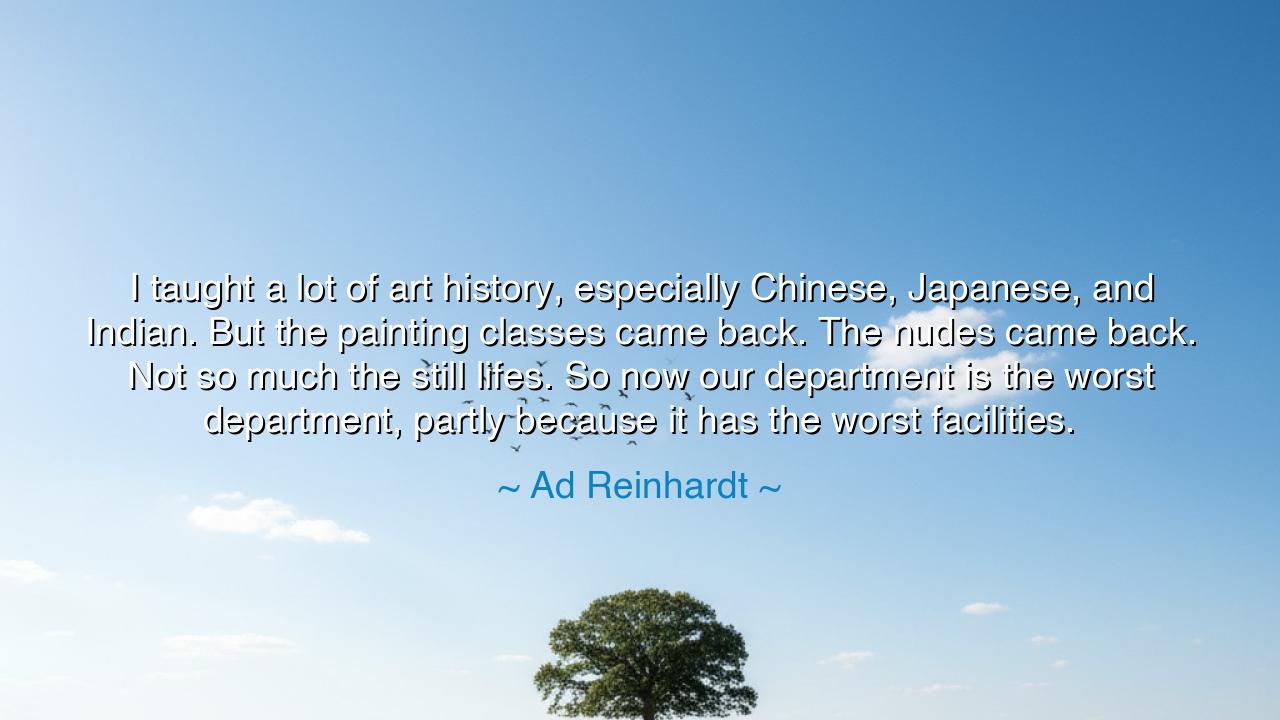
I taught a lot of art history, especially Chinese, Japanese, and
I taught a lot of art history, especially Chinese, Japanese, and Indian. But the painting classes came back. The nudes came back. Not so much the still lifes. So now our department is the worst department, partly because it has the worst facilities.






Ad Reinhardt, the austere prophet of modern abstraction, once spoke with disarming candor: “I taught a lot of art history, especially Chinese, Japanese, and Indian. But the painting classes came back. The nudes came back. Not so much the still lifes. So now our department is the worst department, partly because it has the worst facilities.” To the untrained ear, these words may sound ironic or bitter; yet beneath their surface lies a deep lament for the state of art and its teaching. Reinhardt, who dedicated his life to purifying art to its essence, was not merely criticizing a building or curriculum — he was mourning the loss of discipline and integrity in the creative spirit.
The meaning of this quote lies in the tension between art as a sacred pursuit and art as an institutional commodity. Reinhardt, a man who believed in the spiritual purity of abstraction, viewed the resurgence of painting classes, of nudes and still lifes, not as a triumph of tradition but as a return to mediocrity — to the superficial and decorative. In his eyes, these forms had become exercises without meaning, repeated endlessly without thought or innovation. The “worst department” was not defined by its crumbling walls or poor lighting, but by its failure of purpose. It had ceased to be a temple of inquiry and become a workshop of repetition.
The origin of this reflection comes from Reinhardt’s own life as both artist and teacher. In the mid-twentieth century, he stood as a pillar among the Abstract Expressionists, yet he rejected even their emotional chaos, seeking instead the absolute zero of painting — pure black canvases, free from subject, emotion, or ego. He also taught at universities, where he witnessed art education becoming mechanical and uninspired. When he said the painting classes “came back,” he was not celebrating their return but lamenting that the deeper vision of art — the search for truth — had vanished. For him, art was not to entertain or impress; it was to reveal the invisible.
To understand his despair, one must look to history. Consider the Renaissance academies, where students labored endlessly over anatomy, perspective, and proportion. These were not meaningless studies; they were the means to an end — the pursuit of harmony between form and idea. But as time passed, imitation replaced inspiration, and the sacred study of beauty became an exercise in convention. In much the same way, Reinhardt saw his own age falling into this trap — students learning how to draw the body, but forgetting why to draw it. Art, in his view, had become a mirror reflecting nothing but itself.
Reinhardt’s remark about the “worst facilities” is also rich in symbolism. It is easy to think he spoke of the physical space — the paint-crusted sinks, the dim light, the broken easels. Yet on a deeper level, he was speaking of the facilities of the mind and spirit. When the soul of an artist grows complacent, when the imagination is starved and the will to question fades, even the grandest studio becomes a ruin. The worst department, then, is not the one with the fewest resources, but the one with the weakest convictions. True art thrives not in luxury, but in clarity; it requires not better tools, but a purer vision.
We see this truth reflected in every age. The ancient Chinese scholars, painting with brushes made of reeds and soot, created worlds of infinite stillness and motion with the simplest means. The Japanese Zen monks, using nothing but ink and silence, captured eternity in a single stroke. Their facilities were humble, yet their art was divine. Reinhardt’s frustration, therefore, is a plea to remember that art is not born of wealth or fashion, but of devotion — that the quality of creation depends on the quality of the spirit that creates.
The lesson of Reinhardt’s lament is thus a call to every creator, every teacher, every student of beauty: return to meaning. Do not measure greatness by popularity or comfort. Seek not what pleases the eye, but what awakens the soul. Do not allow art to decay into craft, or knowledge into habit. Let your work be an inquiry, a prayer, a question that demands truth. Facilities may fail, institutions may decay, but the heart that seeks the eternal — that refuses to compromise — will always produce art that endures.
So, my children of creation, remember Reinhardt’s sorrow as both warning and wisdom: the worst department is not the poorest, but the one that has forgotten why it exists. Guard your craft from comfort, and your vision from vanity. Let art be again what it was in the beginning — not a performance, but a pilgrimage; not a profession, but a sacred dialogue between the human and the divine.






AAdministratorAdministrator
Welcome, honored guests. Please leave a comment, we will respond soon